Jan Bartek – AncientPages.com – As the ice melts scientists have a good opportunity to discover prehistoric objects that were once used on a daily basis by ancient people. These rare artifacts have been buried beneath the cold snow for a long time and they offer a good window into the past and daily life of our ancestors.
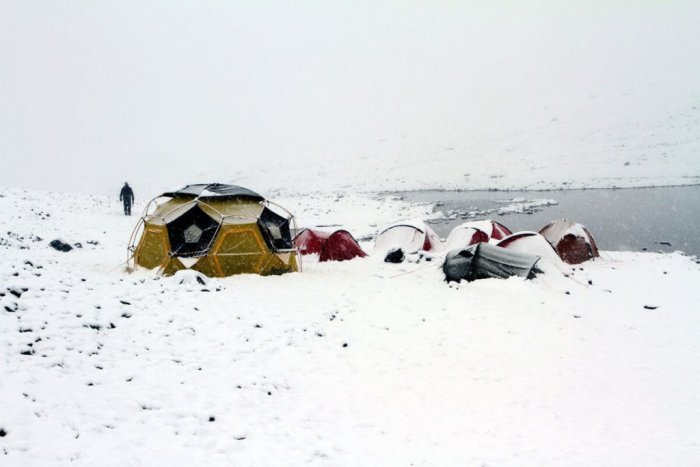
The weather in the high mountains can be challenging for archaeological fieldwork. Credit: Secrets of the Ice
Glacier archaeology has become a sparking a brand-new field of research, and progress is made regularly, but it’s a stressful job. As previously discussed, one has to keep in mind that “the melting of the ice has offered an opportunity” to dramatically expand understanding of mountain life millennia ago, but to archaeologists, climate change is also a threat.
Unless the artifacts can be found quickly, they will be destroyed. Currently, these ancient objects are protected by thick layers of ice, but organic materials freed from the ice rapidly disintegrate and disappear.”
Scientists participating in the Secrets of the Ice project have found many rare, ancient artifacts on the Langfonne ice patch that was once a Viking trade route in Norway.
Excavating in such harsh and cold conditions is challenging, but the weather is not the only problem archaeologists have to deal with.
“We get angry reactions to our finds from climate science deniers all the time,” Lars Pilø, the lead archaeologist on the Secret of the Ice project, told Artnet News. “The whole idea that one can disprove the climate science behind global warming with archaeological finds shows a stunning level of ignorance.”
“One important point to note is that the present glaciers and ice patches are not remnants of the ice sheet that covered Scandinavia during the last Ice Age.
If we go back 6000-8000 years, most of the glaciers in the northern hemisphere were gone. During the so-called Holocene Thermal Optimum, gradual changes in the Earth’s orbit led to warmer summers than today. Slowly this orbital change should cause lower global mean summer temperatures in the Northern Hemisphere and send the Earth on its way into a new ice age if it were not for human greenhouse gas emissions.
The glacial ice in the high mountains has accumulated since the end of the Holocene Thermal Optimum. This has not been a linear process, however, as many natural factors other than planetary orbit influence the climate. The ice has been expanding and contracting over time. Now, with anthropogenic global warming at play, the ice is retreating,” scientists explain.
The number of interesting artifacts recovered from the ice in this region is impressive and each of the objects has a story to tell about our ancestors.
The Rare Lendbreen Tunic
Clothes like the unearthed tunic reveal how people dressed in those days. The textile bundle was unwrapped in the laboratory and turned out to be a complete tunic. A radiocarbon date showed that it was c. 1700 years old. The Iron Age tunic from Lendbreen is a very rare piece of clothing.
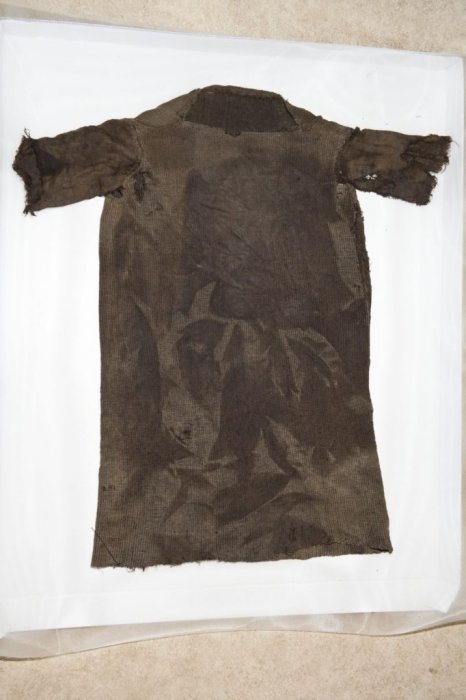
The Iron Age tunic from Lendbreen after conservation. PH๏τo: Mårten Teigen, Museum of Cultural History.
The tunic is made from wool, which was spun and woven. It survived because it has been inside the ice for most of the time since it was lost.
Clothing is also known from glaciated mountain pᴀsses in the Alps. One reason they were left there could be hypothermia. When people are freezing to death, they become very warm in the final stage, which can lead to undressing—a paradoxical behavior.
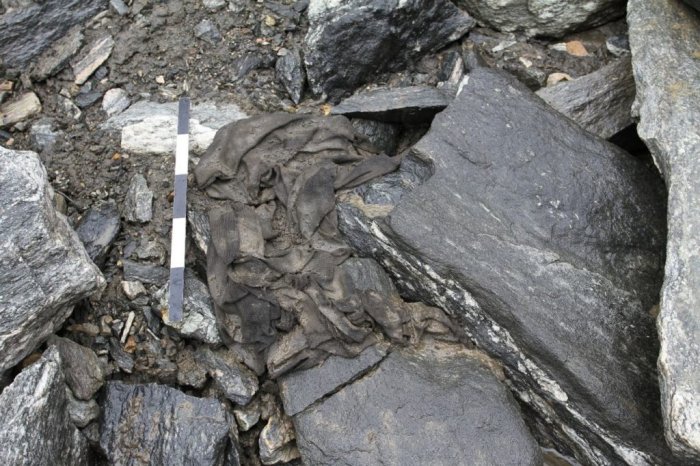
The Lendbreen tunic, which dates to the year 300, is the oldest piece of clothing ever found in Norway. Credit: Secrets of the Ice
According to the Secret of the Ice project, “more than 70 pieces of textile have also been found at the ice sites in Oppland. These appear to be cut-off pieces of textile, or simply rags. They had reached the end of their life as clothes and were being used for a variety of purposes.”
A Wooden Whisk
In the Lendbreen pᴀss, scientists also found a wooden whisk, radiocarbon-dated to the 11th century A.D. It is unusual for whisks, such as this one, to have a pointed end, so it may have been used secondarily for something else, not its original purpose. Maybe as a tent plug?
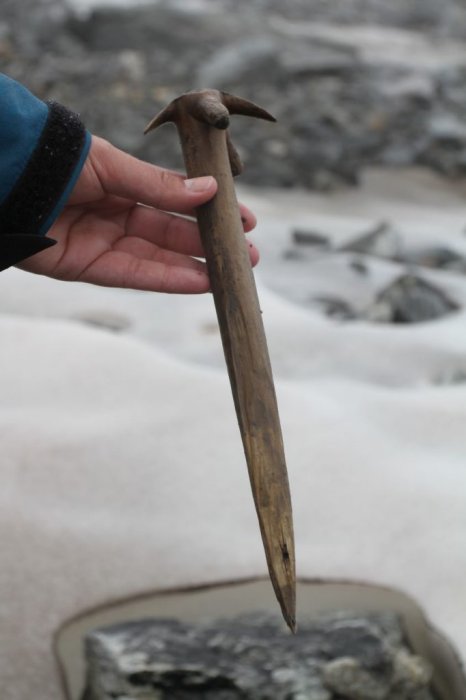
A wooden whisk, found at Lendbreen. Radiocarbon-dated to be c. 1000 years old. PH๏τo: Vivian Wangen, Museum of Cultural History.
“The whisk is a kitchen utensil used for stirring [foods like] porridge. It is probably an accidental loss on the route between the main farm and the summer farm. Such whisks are still made today, but they are usually not pointed, so this artifact may have been used secondarily for another purpose, perhaps as a tent peg,” Artnet News reports.
Horse Snowshoes
More than 20 horseshoes have been recovered from Lendbreen. Horseshoes were used from the 11th century onwards in Norway and have changed their shape over time. This allows dating of them. Most of the horseshoes from Lendbreen are Medieval (AD 1050-1537).
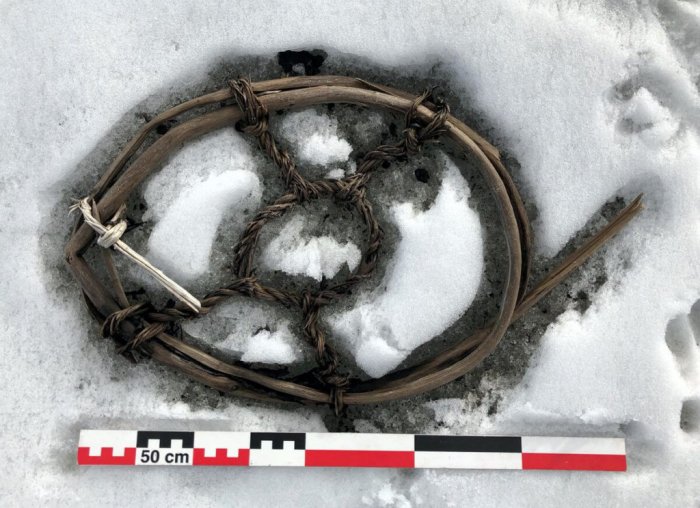
The horse snowshoe found in the Lendbreen pᴀss. Credit: Espen Finstad, Secrets of the Ice.
“Horse snowshoes are known from historical sources. However, to our knowledge, this is the first horse snowshoe found on an archaeological site. We have two more such snowshoes from Lendbreen that are less well preserved. The snowshoe was used when the snow was either powdery or rotten, so winter or spring/early summer. They are not necessary when the snow is firm. Losing one of them would make crossing the snow more difficult, depending on the snow conditions,” Secret of the Ice project’s scientists explain.
A Complete Tinderbox
“The tinderbox contained a wooden stick and small bits of resin-filled wood. It is not dated or analyzed yet. It is probably an accidental loss since it is complete.
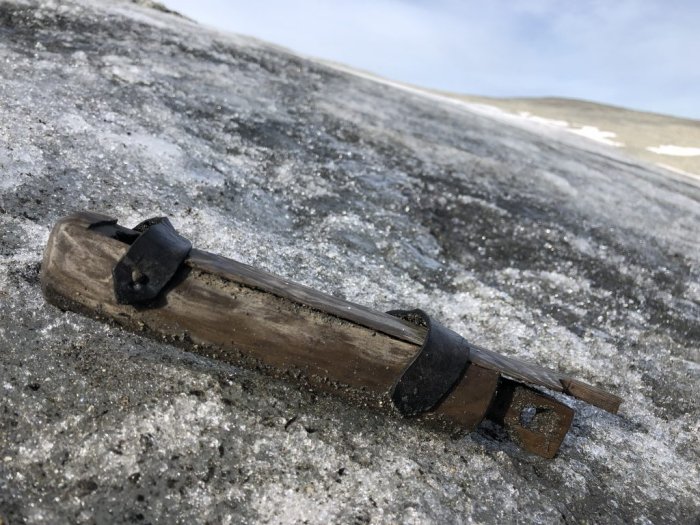
A tinderbox found in the Lendbreen pᴀss. Credit: Espen Finstad, Secrets of the Ice.
We think that it is likely to date to the Viking Age or the Medieval Period (500 to 1000 years old), but it could also be younger—or older.”
See also: More Archaeology News
These are just some of the many artifacts that have been found beneath the ice in Norway and we can say with confidence archaeologists working at the site will most likely find new items that can add valuable information to our history books and shed new light on the daily life of people who lived in this part of the world.
Glacier archaeology remains a fascinating and promising field.
Written by Jan Bartek – AncientPages.com Staff Writer





